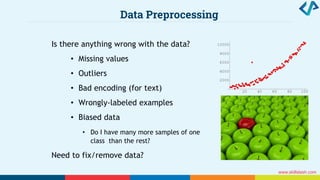Machine Learning - Lecture1.pptx.pdf
- 1. Machine Learning-1 Presented by Skillslash
- 2. What is MC Learning www.skillslash.com The subfield of computer science that “gives computers the ability to learn without being explicitly programmed”. (Arthur Samuel, 1959) A computer program is said to learn from experience E with respect to some class of tasks T and performance measure P if its performance at tasks in T, as measured by P, improves with experience E.” (Tom Mitchell, 1997) Using data for answering questions
- 40. High Bias and Low Variance (Low Flexibility) Low Bias and High Variance (Too Flexibility) Low Bias and High Variance (Balanced Flexibility)
- 41. Bias Error: The bias is known as the difference between the prediction of the values by the ML model and the correct value. Being high in biasing gives a large error in training as well as testing data. Variance Error: Variance is the amount that the estimate of the target function will change if different training data was used.
- 42. www.skillslash.com Types of Machine Learning
- 43. Supervised Learning vs Unsupervised Learning
- 47. Clustering
- 50. Types of Supervised ML Supervise d Unsupervise d Reinforceme nt Output is a discrete variable (e.g., Defaulter and Non Defaulter Spam and non spam Purchaser Non Purchaser) Classificatio n Regressio n Output is continuous (e.g., price of house, temperature) www.skillslash.com
- 55. Types of Machine Learning Problems Supervise d Unsupervise d Reinforceme nt Supervise d Is this a cat or a dog? Are these emails spam or not? Unsupervised Predict the market value of houses, given the square meters, number of rooms, neighborhood, etc. Reinforcement Learn through examples of which we know the desired output (what we want to predict).
- 56. Types of Machine Learning Problems Unsupervise d Supervised There is no desired output. Learn something about the data. Latent relationships. I want to find anomalies in the credit card usage patterns of my customers. Reinforcement I have photos and want to put them in 20 groups. www.skillslash.com
- 57. Types of Machine Learning Problems Unsupervise d Supervise d Reinforceme nt Useful for learning structure in the data (clustering), hidden correlations, reduce dimensionality, etc. www.skillslash.com
- 58. Environment gives feedback via a positive or negative reward signal. Unsupervised Reinforceme nt Supervise d An agent interacts with an environment and watches the result of the interaction. Types of Machine Learning Problems www.skillslash.com
- 60. Data Gathering 60 Might depend on human work • Manual labeling for supervised learning. • Domain knowledge. Maybe even experts. May come for free, or “sort of” • E.g., Machine Translation. The more the better: Some algorithms need large amounts of data to be useful (e.g., neural networks). The quantity and quality of data dictate the model accuracy www.skillslash.com
- 61. Data Preprocessing 61 Is there anything wrong with the data? • Missing values • Outliers • Bad encoding (for text) • Wrongly-labeled examples • Biased data • Do I have many more samples of one class than the rest? Need to fix/remove data? www.skillslash.com
- 62. Feature Engineering 62 What is a feature? A feature is an individual measurable property of a phenomenon being observed Our inputs are represented by a set of features. To classify spam email, features could be: • Number of words that have been ch4ng3d like this. • Language of the email Buy ch34p drugs from the ph4rm4cy now :) :) :) (2, 0, 3) Feature engineerin g www.skillslash.com
- 63. Feature Engineering 63 Extract more information from existing data, not adding “new” data per-se • Making it more useful • With good features, most algorithms can learn faster It can be an art • Requires thought and knowledge of the data Two steps: • Variable transformation (e.g., dates into weekdays, normalizing) www.skillslash.com
- 64. Algorithm Selection & Training 64 Supervise d • Linear classifier • Naive Bayes • Support Vector Machines (SVM) • Decision Tree • Random Forests • k-Nearest Neighbors • Neural Networks (Deep learning) Unsupervise d • PCA • t-SNE • k-mean s • DBSCAN Reinforcemen t • SARSA–λ • Q-Learnin g www.skillslash.com
- 65. 65 THE MACHINE LEARNING FRAMEWORK y = f(x) ● Training: given a training set of labeled examples {(x1 ,y1 ), …, (xN ,yN )}, estimate the prediction function f by minimizing the prediction error on the training set ● Testing: apply f to a never before seen test example x and output the predicted value y = f(x) output prediction function Image feature www.skillslash.com
- 66. Goal of training: making the correct prediction as often as possible • Incremental improvement: • Use of metrics for evaluating performance and comparing solutions • Hyperparameter tuning: more an art than a science Algorithm Selection & Training 66 Predic t Adjus t www.skillslash.com
- 67. Summary 67 • Machine Learning is intelligent use of data to answer questions • Enabled by an exponential increase in computing power and data availability • Three big types of problems: supervised, unsupervised, reinforcement • 5 steps to every machine learning solution: 1. Data Gathering 2. Data Preprocessing 3. Feature Engineering 4. Algorithm Selection & Training 5. Making Predictions www.skillslash.com
- 68. Generalization ● How well does a learned model generalize from the data it was trained on to a new test set? Training set (labels known) Test set (labels unknown)
- 69. Generalization ● Components of generalization error ○ Bias: how much the average model over all training sets differ from the true model? ■ Error due to inaccurate assumptions/simplifications made by the model ■ Using very less features ○ Variance: how much models estimated from different training sets differ from each other ● Underfitting: model is too “simple” to represent all the relevant class characteristics ○ High bias and low variance ○ High training error and high test error ● Overfitting: model is too “complex” and fits irrelevant characteristics (noise) in the data ○ Low bias and high variance ○ Low training error and high test error
- 72. Bias-Variance Trade-off • Models with too few parameters are inaccurate because of a large bias (not enough flexibility). • Bias can also come due to wrong assumption. • Lead to Train error • Models with too many parameters are inaccurate because of a large variance (too much sensitivity to the sample). • Lead to Test Error



























































































